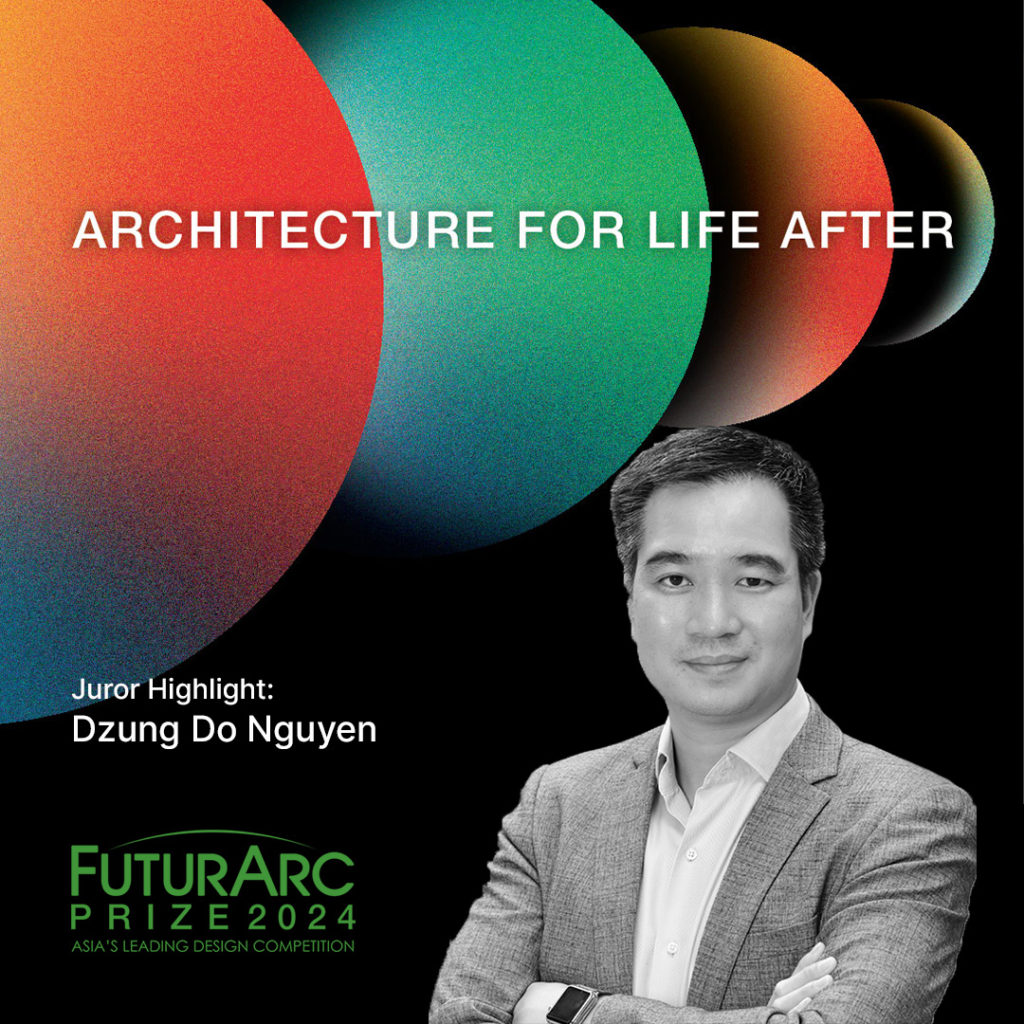FuturArc Prize 2024 Juror Highlight: Dzung Do Nguyen
January 12, 2024

Dzung Do Nguyen, Co-Founder and CEO of enCity and enfarm Agritech, is an expert in urban development with comprehensive experience across Asia. His work primarily focuses on strategic city development, smart city planning and water-sensitive urban design, among others.
He has led multidisciplinary teams and engaged decision-makers in the real estate sector and government agencies, innovating with market-responsive, context-sensitive and implementation-ready urban solutions. His projects have received awards from the International Society of City and Regional Planners (ISOCARP) and the American Institute of Certified Planners (AICP).
Over the years, Dzung has contributed articles to FuturArc along with his colleagues at enCity, advocating for a resilient built environment that is rooted in natural ecologies. Take a look at their articles below, and find out more about enCity’s projects that respond to the threats of climate disaster while also seizing upon site-specific opportunities.
The Ecosystems of Water

EMBRACING THE CENTRAL ROLE THAT WATER PLAYS IN ECOLOGY, CULTURE AND ECONOMY
Life begins with water—this is a fact that goes back to the beginning of human civilisation. Many urban settlements began by organising around river banks and estuaries, where the soil is fertile, fresh water is abundant, and means of subsistence are available.
Most recently, in the past century or so, climate change has turned water from an object of awe and inspiration into one of immense threat to our sustainable development. Water is now frequently associated with unpredictable rainfalls, uncontrollable floods, rising sea levels, loss of groundwater and sinking cities.
Managing water threats cannot be equated with keeping water at bay. New movements like Living with water have arisen, in which water resource management is seen as a comprehensive and context-sensitive discipline, rather than just the mitigation of threats.
Read more: https://www.futurarc.com/commentary/the-ecosystems-of-water/
City Profile: Hoi An

A CITY OF BUILT AND NATURAL HERITAGE
Hoi An typically draws up to 4 million visitors every year with its rich cultural heritage and stunning natural setting. The 2020 pandemic and severe floods have reminded the locals that they cannot depend on tourism and the city’s built heritage to make a living. It reduced tourist revenue by over 80 per cent in 2020 compared to 2019, and forced 90 per cent of shops in the old town to close down.
However, it also has the unexpected result of revitalising the city’s farmlands, as residents sought alternative means of food security, a stable source of income, and domestic tourism offerings that avoided crowded, narrow streets.
Read more: https://www.futurarc.com/commentary/hoi-an/
Casamia Development

Casamia is one of the first large-scale developments along Hoi An’s coastal highway. Where conventional developments use infill to raise the land and embankments or dykes to keep the water out, Casamia’s master plan optimises land values by opening the site to the Co Co River, creating an internal water body and a park to provide every parcel with access to open space.
The master plan proposal ensures that the nipa palm forest is fully conserved and even expanded into the residential areas of the site. The location, on former aquaculture land, also reduces development pressure on farmland and forests in the surrounding Cam Thanh district.
Read more about the project: https://encity.co/hoi-an-waterfront-eco-community/
GS Metro Long Binh Mixed-use Community


Located in Thu Duc City, the site contains a former stone quarry submerged in murky waters—a ‘scarred’ landscape that shows the fragmented industrial nature of the wider Long Binh area.
It is strategically positioned close to the Thu Thiem financial centre, a national university and Saigon Hi-Tech Park. A light rail is planned connect the site to the rest of the city, providing the opportunity for an integrated urban development.
However, the area lacked a key anchor, with shared facilities being gated. Hence, the master plan by enCity centres public space and community amenities at the heart of the development, creating a warm and inclusive place for everyone. It also responds to the quarry lake by reimagining its waterfront experience.
Read more: https://encity.co/gs-metro-long-binh-mixed-use-community/
Hue Sanctuary: A new urban hub that integrates existing communities

Adapting to water has long been a way of life in Hue, but urban growth may intensify the risks of flooding. The site for this development lies on a floodplain that is frequented by seasonal deluge—the floodwaters can even reach over 5 metres in 20-year extreme events.
In 2020, major floods submerged houses in the area, further worsened by the channelling of floodwaters from the Hue citadel. A careful water management system is necessary to ensure a safe and sustainable urban environment.
In the effort to utilise Nature-based solutions, the team identified that the site served as an important area migratory birds, mangroves and mudflats, yet some of that has been lost to agricultural development and urbanisation.
The proposal expands existing waterways into the site to increase catchment area as an extreme flood protection strategy. In several phases, the mixed-use district is aimed to be built with riverine parklands, a bird sanctuary, a wetland park and eco-tourism river belts.

Read more: https://encity.co/hue-sanctuary/
The competition ends 9 February 2024! Don’t forget to submit your entries for FuturArc Prize 2024: Architecture for Life After … and get the chance to win cash prizes!

To read the complete article, get your hardcopy at our online shop/newsstands/major bookstores; subscribe to FuturArc or download the FuturArc App to read the issues!
Previously Published Online Exclusive Feature
Contact us at https://www.futurarc.com/contact-us for older interviews.


